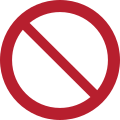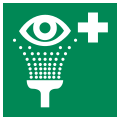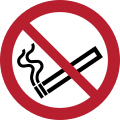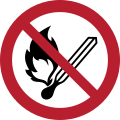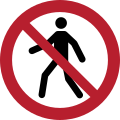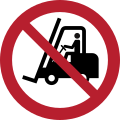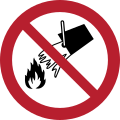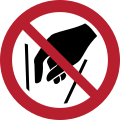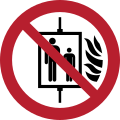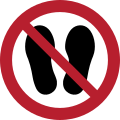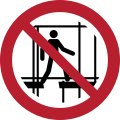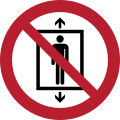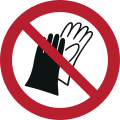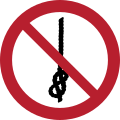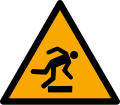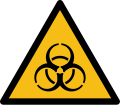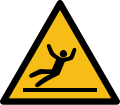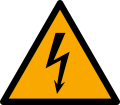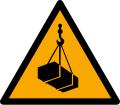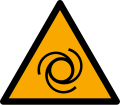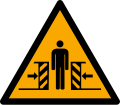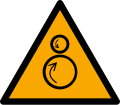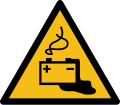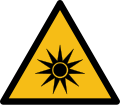Commons:Deletion requests/Files in Category:ISO 7010 safety signs (vector drawings)
Files in Category:ISO 7010 safety signs (vector drawings)[edit]
Request via. OTRS (Ticket:2015120310015731) - it appears these may be copyrighted, and PD-ineligible.
--Mdann52talk to me! 20:21, 10 December 2015 (UTC)
- And who should be the copyright holder? --2A02:810D:1180:108:11C0:39E8:57C1:8AFC 20:36, 10 December 2015 (UTC)
- Could we please get details about the ticket mentioned above? Deleting these would not also be kind of disastrous, it also kind of against the idea of those symbols. --Sebari (talk) 20:58, 10 December 2015 (UTC)
- The copyright holder is the ISO organisation, who have contested the CC and PD licences these are tagged with (I agree personally, I think these pass the threshold of originality). In any case, they are open to us using some under fair use (although that's another issue). --Mdann52talk to me! 21:09, 10 December 2015 (UTC)
- Could we please get details about the ticket mentioned above? Deleting these would not also be kind of disastrous, it also kind of against the idea of those symbols. --Sebari (talk) 20:58, 10 December 2015 (UTC)
- Some of them (the first two, certainly) are unlikely to be original enough to be copyrighted in the US. I don't know about country of origin here so they either should be kept (if it's the US or a place with an US like TOO) or deleted here and uploaded maybe on projects where they'd be acceptable. We can't accept them as "fair use" here, of course.Jo-Jo Eumerus (talk) 21:15, 10 December 2015 (UTC)
- Aren't international standards like ISO in the public domain and open to access? Copyrighting them defeats the purpose of standardisation. Also I've scrolled through quite a few of these that would definitely be PD-simple no matter who protests that they have rights, such as File:ISO 7010 W027.svg and File:ISO 7010 Fire protection arrow 2.svg.
 Keep Fry1989 eh? 21:28, 10 December 2015 (UTC)
Keep Fry1989 eh? 21:28, 10 December 2015 (UTC)
- Unfortunately not, ISO standards and publications are protected by copyright. They've got a whole brochure in which they complain about unauthorized reproductions of their standards documents. However, sometimes ISO standards get incorporated verbatim into law, in which case they can be {{PD-EdictGov}}. Many of these symbols are indeed ineligible for copyright protection in the U.S., for example File:ISO 7010 P001.svg —RP88 (talk) 21:38, 10 December 2015 (UTC)
- Strange. However as stated below, a lot of these signs also overlap with EU, DIN, Canadian, American and Australian standards. Only those that are truly original to ISO should qualify for deletion. Fry1989 eh? 21:52, 10 December 2015 (UTC)
- Unfortunately not, ISO standards and publications are protected by copyright. They've got a whole brochure in which they complain about unauthorized reproductions of their standards documents. However, sometimes ISO standards get incorporated verbatim into law, in which case they can be {{PD-EdictGov}}. Many of these symbols are indeed ineligible for copyright protection in the U.S., for example File:ISO 7010 P001.svg —RP88 (talk) 21:38, 10 December 2015 (UTC)
- Aren't international standards like ISO in the public domain and open to access? Copyrighting them defeats the purpose of standardisation. Also I've scrolled through quite a few of these that would definitely be PD-simple no matter who protests that they have rights, such as File:ISO 7010 W027.svg and File:ISO 7010 Fire protection arrow 2.svg.
Many of those signs aren't new but derived from Category:DIN 4844-2 safety signs (vector drawings). --2A02:810D:1180:108:11C0:39E8:57C1:8AFC 21:30, 10 December 2015 (UTC)
- That is also something that needs to be looked at. A lot of DIN, ISO and EU standard symbols overlap. Fry1989 eh? 21:34, 10 December 2015 (UTC)
- What is the copyright status of EU and DIN symbols? I checked some random DIN symbols on Commons, and they were tagged as PD-self, which looks wrong. --Stefan2 (talk) 23:52, 10 December 2015 (UTC)
- DIN standards are protected by copyright, although the DIN symbols may be below TOO in Germany. One set of safety symbols that are unquestionably public domain are the AIGA symbols. The AIGA symbols in Category:AIGA symbol signs and Category:Inverted AIGA symbol signs were produced through a collaboration between AIGA and the U.S. Department of Transportation) in 1974 and 1979 and are in the public domain. —RP88 (talk) 03:15, 11 December 2015 (UTC)
- What is the copyright status of EU and DIN symbols? I checked some random DIN symbols on Commons, and they were tagged as PD-self, which looks wrong. --Stefan2 (talk) 23:52, 10 December 2015 (UTC)
Thank you for opening this DR. I do wonder. If they complain a lot about copyright infringement, shouldn't there be some court rulings? Natuur12 (talk) 23:00, 10 December 2015 (UTC)
- I did find this for Brazil.Jo-Jo Eumerus (talk) 23:23, 10 December 2015 (UTC)
- That is problematic, because it says the court recognises "unconditional copyright", which would ignore imagery that is PD due to simplicity as already pointed out here with some of the files in question. Fry1989 eh? 23:43, 10 December 2015 (UTC)
- Mind you, that is Brazilian jurisprudence. It's not a given that US and country-of-origin jurisprudence agrees with that. COM:TOO has nothing about Brazil at all unfortunately.Jo-Jo Eumerus (talk) 23:50, 10 December 2015 (UTC)
- That is problematic, because it says the court recognises "unconditional copyright", which would ignore imagery that is PD due to simplicity as already pointed out here with some of the files in question. Fry1989 eh? 23:43, 10 December 2015 (UTC)
- ISO is located in Switzerland, so is that the source country? COM:TOO doesn't have a lot of information about Swiss symbols, so it is difficult to determine whether the symbols are copyrighted in Switzerland or not. Some of the symbols are below the threshold of originality in the United States while other symbols seem to be above the threshold of originality. It might be better to split up the set on smaller groups depending on art complexity. --Stefan2 (talk) 23:52, 10 December 2015 (UTC)
- DIN norms come from Germany. en:CEN is in Bruxelles. Per their history, ISO was formed in London but the first standard was published after their seating to Switzerland. I don't know when it started creating (or assembling already existing?) symbols, though. Assuming that that makes Switzerland the Country of Origin, the law in question requires "mental (?) creations with individual character". Given that unlike the US not all photographies qualify as such I am guessing that it's about the same standard as the US, a bit more permissive maybe.Jo-Jo Eumerus (talk) 00:10, 11 December 2015 (UTC)
- The ISO policies site states that "any dispute arising in connection with this Privacy Policy shall be governed exclusively by Swiss law with the exclusion of its international private law. Exclusive place of jurisdiction shall be Zurich, Switzerland." So I suppose we are talking about Swiss copyright. De728631 (talk) 00:11, 11 December 2015 (UTC)
- @Jo-Jo Eumerus: A creative work per Swiss law is defined as follows: "Werke sind, unabhängig von ihrem Wert oder Zweck, geistige Schöpfungen der Literatur und Kunst, die individuellen Charakter haben." That translates to "Works are, regardless of their value or purpose, intellectual creations of literature and fine arts with an individual character." I am reluctantly doubtful that the ISO symbols are individual enough to reach a copyrightable status according to this definition. At least simple arrows would surely not be creative enough given that simple photographic snapshots aren't either.
- On the other hand there is this recent ruling in Germany which says that even DIN standards as such are subject to copyright, although this is possibly mostly related to the text part. So the "inherited" symbols are not be free by default. De728631 (talk) 00:31, 11 December 2015 (UTC)
- I've tracked down some more TOO cases: (three dimensional raw models), (TOO photographies), (things that make photographies copyrightable), (TOO for text), TOO for text #2), (furniture) and (recording of played music). I agree with keeping the simple arrows, at least - unless the underlying SVG code is also an issue, then we'll need usermade SVGs for these. Jo-Jo Eumerus (talk) 10:10, 11 December 2015 (UTC)
- The svg files are "usermade". --тнояsтеn ⇔ 11:40, 11 December 2015 (UTC)
- I've tracked down some more TOO cases: (three dimensional raw models), (TOO photographies), (things that make photographies copyrightable), (TOO for text), TOO for text #2), (furniture) and (recording of played music). I agree with keeping the simple arrows, at least - unless the underlying SVG code is also an issue, then we'll need usermade SVGs for these. Jo-Jo Eumerus (talk) 10:10, 11 December 2015 (UTC)
- File:ISO 7010 E003 - First aid sign.svg is "PD-shape" and uncopyrightable unde3r United States laws. AnonMoos (talk) 07:09, 11 December 2015 (UTC)
Those signs are published as well in ASR A1.3 which implements Directive 92/58/EEC - safety and/or health signs in Germany. --тнояsтеn ⇔ 07:25, 11 December 2015 (UTC)
- strong keep, the ISO claims are ridiculous, they are anything but the holder of copyright. Unless they name the creators of each and every of those signs and are able to provide us with a full chain of transfer from the original creator to themselves, we should simply ignore them. Even if they could provide such a chain of transfer, they would still have to prove that each and every sign was original at the time of drawing, and the differences from any older sign met the threshold of originality. Basically their notice is fraudulent and I might suggest to threaten them with a counter law suit for copyfraud. At best it is a FUD-strategy. --h-stt ⁉ 15:50, 11 December 2015 (UTC)
- Good point. After all there doesn't seem to be anything like corporate authorship in Swiss copyright law. Copyright is held by any natural person who created a work, but it can be transferred Article 16. So ISO would have to show that all designers agreed to transfer their idividual copyrights in those icons. De728631 (talk) 16:59, 11 December 2015 (UTC)
- ISO can be owner of rules, they create, but not of this signs: Nearly all this sign are copies of much older signs in the German DIN. DIN, as a German organisation, works under the conditions of the German copyright law. The German copyright law declares, that only such works can be copyrighted, whish are not of a poor level (of design, idea and so on), in German called "Schöpfungshöhe". As a result of this law, texts from DIN are copyrighted, because their level is high enough, but the signs are not, because they are either very easy geometric forms (safety signs) or or not an idea of DIN. Example: Why do we know, that the signs in Category:ISO 7010 prohibition signs are prohibition signs? We know it, because they are round, have a red border and a red strike-through. This meaning has the historical root in road signs with the meaning of a prohibition for the object, wich is striked. Road signs are content of a law and therefore public domain. So, the idea, to use red border and red strike to create a symbol is not from DIN and not from ISO, its from laws and PD. To strike-through other things is to low in idea for copyright. Antonsusi (talk) 21:01, 11 December 2015 (UTC)
- Even if the copyright is held by the individual designers instead of ISO, this doesn't make them less copyrighted. It only affects whom you should ask for an OTRS permission with respect to the copyrighted signs. --Stefan2 (talk) 22:39, 11 December 2015 (UTC)
- ISO can be owner of rules, they create, but not of this signs: Nearly all this sign are copies of much older signs in the German DIN. DIN, as a German organisation, works under the conditions of the German copyright law. The German copyright law declares, that only such works can be copyrighted, whish are not of a poor level (of design, idea and so on), in German called "Schöpfungshöhe". As a result of this law, texts from DIN are copyrighted, because their level is high enough, but the signs are not, because they are either very easy geometric forms (safety signs) or or not an idea of DIN. Example: Why do we know, that the signs in Category:ISO 7010 prohibition signs are prohibition signs? We know it, because they are round, have a red border and a red strike-through. This meaning has the historical root in road signs with the meaning of a prohibition for the object, wich is striked. Road signs are content of a law and therefore public domain. So, the idea, to use red border and red strike to create a symbol is not from DIN and not from ISO, its from laws and PD. To strike-through other things is to low in idea for copyright. Antonsusi (talk) 21:01, 11 December 2015 (UTC)
- Good point. After all there doesn't seem to be anything like corporate authorship in Swiss copyright law. Copyright is held by any natural person who created a work, but it can be transferred Article 16. So ISO would have to show that all designers agreed to transfer their idividual copyrights in those icons. De728631 (talk) 16:59, 11 December 2015 (UTC)
 Keep Das sind Amtliche Werke und somit gemeinfrei. --Pölkkyposkisolisti (talk) 21:53, 11 December 2015 (UTC) Und WMDE sollte eine Klage wegen Schutzrechtsberühmung anstreben, um solchem Unsinn mal endlich entgegenzuwirken.
Keep Das sind Amtliche Werke und somit gemeinfrei. --Pölkkyposkisolisti (talk) 21:53, 11 December 2015 (UTC) Und WMDE sollte eine Klage wegen Schutzrechtsberühmung anstreben, um solchem Unsinn mal endlich entgegenzuwirken.
- According to Commons:WikiProject Public Domain/German stamps review, {{PD-GermanGov}} only covers literary works but not artworks, so the DIN symbols seem to be unfree in the source country. I don't know whether artworks are covered by the Swiss exemption for official works, but these do not seem to be government works in the first place. --Stefan2 (talk) 22:39, 11 December 2015 (UTC)
- DIN signs are usually to poor in the level of creativity to have German copyright and in addition to that, a lot of them are not created by the DIN organisation. Antonsusi (talk) 17:57, 14 December 2015 (UTC)
- According to Commons:WikiProject Public Domain/German stamps review, {{PD-GermanGov}} only covers literary works but not artworks, so the DIN symbols seem to be unfree in the source country. I don't know whether artworks are covered by the Swiss exemption for official works, but these do not seem to be government works in the first place. --Stefan2 (talk) 22:39, 11 December 2015 (UTC)
- This is indeed a bit strange (I feel it's like all traffic-signs get deleted). If we let the laws here aside, this copyright is just a rape to get money. But who cares? It is industry, we are only slaves of the industry. In the EU there is no government anymore.
- PS: Then also with the same reasons all in Category:DIN 4844-2 safety signs (vector drawings) must be deleted (also the vector format should not matter)⁉ ↔ User: Perhelion (Commons: = crap?) 03:41, 17 December 2015 (UTC)
Analyzing individual files[edit]
The following symbols should be unquestionably ineligible for copyright as they are too simple:
| Extended content |
|---|
|
The following symbols are based on the exit symbol ([1]) developed by the Foundation for Promoting Personal Mobility and Ecological Transportation, which says: "The symbols presented in these guidelines can be freely used by anyone and can be accessed at the Web site (http//www.ecomo.or.jp) of the Eco-Mo Foundation. However, registering these symbols as your trademark or design can be a copyright infringement. If you have any questions, please contact us." The adjustments are not sufficient to grant additional copyright:
| Extended content |
|---|
|
|
The following symbols are very likely ineligible for copyright protection:
| Extended content |
|---|
|
The following symbols are otherwise original enough to be given copyright, unless they are nearly identical to copyright-free symbols of other countries:
| Extended content |
|---|
|
I tried to research how the ISO symbols were created, namely to determine when/how they were created. This was one of the first search engine results, but the information about the creation isn't displayed…instead it gives the message: "Only informative sections of standards are publicly available. To view the full content, you will need to purchase the standard by clicking on the "Buy" button." The document is US$193!
For ANSI symbols, one of the FAQ, "Why charge for standards?", says: "Intellectual property and commercial value issues. The information contained in a standard is the intellectual property of the developing organization. When others want to use this property, they are expected to pay a fair value for it. If incorporating the content of a standard is deemed necessary in the development of a product or service, obtaining this intellectual property should be seen as no different from obtaining any other component of the product." Another FAQ is "Why are some documents non printable? Those documents cannot be printed at the request of the copyright holder." Therefore, I can't determine if any of the ANSI symbols are copyright-free. The English Wikipedia article for en:Deutsches Institut für Normung (DIN) says that it is the German member of ISO.
If some of these files need to be deleted, many can be uploaded/used on Wikipedia as fair use. AHeneen (talk) 03:12, 17 December 2015 (UTC)
- Thanks for your extended comment. Indeed many symbols were free in the past or are very similar to old free symbols. So in fact this all is only copyfraud. Anyway it all seems a bad joke, but the industry is the king, she makes the copyright and she can say what is it and what is not. In the German Wikipedia there is no "fair use". ↔ User: Perhelion (Commons: = crap?) 03:49, 17 December 2015 (UTC)
- Maybe it should be spread that these symbols can't be expected to be interpreted by anyone. Honestly: this one clearly means "don't put your arm too far infront of yourself", this one (those are ears, right?) "don't listen to the announcments" (guess why everyone does this, instead of not stepping on the stair cover when the door isn't supposed to open anyway), and this, that there's no repeater signal (for whatever). What? You say it means something different, but I have to pay a few hundered bucks to understand? Well *shrug*… --Nenntmichruhigip (talk) 06:27, 17 December 2015 (UTC)
Kept: No clear evidence that the files in question are copyrighted. ISO organization can sand a DMCA takdown request to WMF (but i think that they won't take it down). Some files are also obvious PD. Steinsplitter (talk) 11:24, 17 December 2015 (UTC)
- I forwarded the otrs complain to wikimedia legal department. Best --Steinsplitter (talk) 11:32, 17 December 2015 (UTC)






